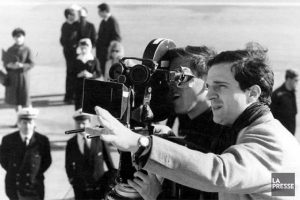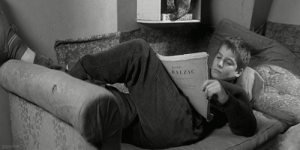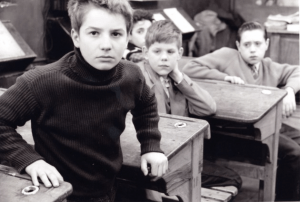Les 400 Coups= The 400 Blows
Truffaut, Godard and Chabrol; the key figures of the French New Wave. They neither wished to continue le cinéma de papa, nor to film in such an expensive manner as the papas once did. These men provided the late 1950s and 1960s audience with a change. The way they filmed was incredibly different to the pre-war cinematography: they rejuvenated the art of the French cinema. The making of a film for a director, as Truffaut once said, was like a pen for a writer. He believed that les réalisateurs need to express their message not only through the words, the script or the acting, yet through the position of the camera and the technical filming of the scenes.
Is it perhaps the reason why Les 400 Coups begins with a travelling shot, as if it was from a point of view of a child sitting at the back seat of a Citroen DS, you may ask? Arguably, it is reflecting the circular movement of the film. Antoine Doinel, a young boy with a difficult childhood described in the plot-line, ends up in une fourgonette. He is taken to the closed centre for young criminals just as if it was a new beginning in the second half of the film. He did not wish to end up there, nor did he wish to be told off by the teacher due to possession of a magazine in a lesson. It was his friend who passed it on, but the chain of events led to him missing school and leaving home. However, he was not particularly discontent about the latter. His mother did not want him, yet her mother forced her to keep a child. The stepfather was not much of a father to him non plus.
Then what makes this film so special? It won the main award in Cannes after Truffaut
was banned from the festival a year before. Surely, there needs to be something… revolutionary? Indeed, this film was a phenomenon. Critically acclaimed to the fact that it followed the auteur theory to the dot. André Bazin, the founder of Cahiers du Cinema and the ‘father’ of the trio- Truffaut; Godard and Chabrol- emphasised that the crucial role in the film is that of the director. He or she is the artistic creator who implements his or her own aesthetic and narrative vision. Indeed, Les 400 coups was heavily autobiographical. Truffaut had a difficult childhood, just as Antoine did. Jean-Pierre Léaud was chosen for this role, as Truffaut saw young himself in this boy. The aesthetics have even come to the point that this French réalisateur allowed the boy to improvise in several scenes of the film.  Truffaut escaped his past and found a new beginning in the cinema. Antoine did so at the beach. I found my passion in French films, in the inevitable sarcasm intertwined with the dramatically plotted, but still rather plain life of les jeunes hommes of Paris. The way they behaved, lived or argued. And in such a French manner. The filming of Antoine’s life and the fashion in which it was filmed was the new beginning and what followed was the unrivaled period in not merely French, but also the world cinema: La Nouvelle Vague
Truffaut escaped his past and found a new beginning in the cinema. Antoine did so at the beach. I found my passion in French films, in the inevitable sarcasm intertwined with the dramatically plotted, but still rather plain life of les jeunes hommes of Paris. The way they behaved, lived or argued. And in such a French manner. The filming of Antoine’s life and the fashion in which it was filmed was the new beginning and what followed was the unrivaled period in not merely French, but also the world cinema: La Nouvelle Vague
le cinema de papa= dad’s cinema- phrase coined by the contributors of Cahiers du Cinéma
les réalisateurs= film directors
une fourgonette= small van
non plus= neither
Cahiers du Cinéma= magazine about cinematography
les jeunes hommes= young men (here: people)
La Nouvelle Vague= The New Wave



Enjoyed the article. Breathless by Goddard is the coolest film of all time imho.